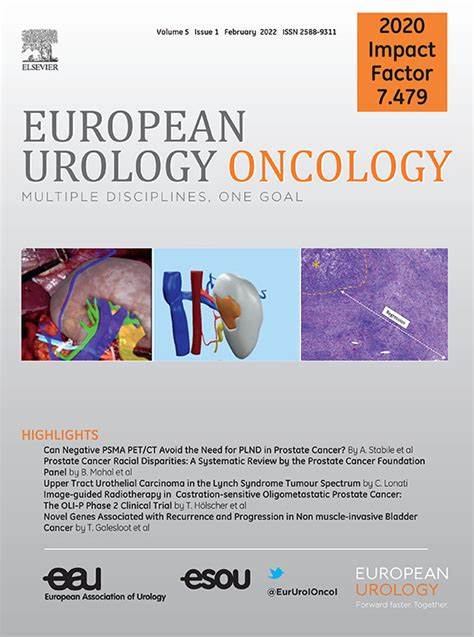预防性喹诺酮类药物联合卡介苗-谷氨酰胺佐剂治疗非肌肉侵袭性膀胱癌的临床效果的系统评价和meta分析。
IF 9.3
1区 医学
Q1 ONCOLOGY
引用次数: 0
摘要
背景和目的:卡介苗(BCG)可减少中高危非肌侵性膀胱癌(NMIBC)的复发和进展。在滴注期间,与bcg相关的不良事件很常见,导致治疗停止。预防性使用喹诺酮类药物同时注射卡介苗是减少BCG相关不良事件的一种方法。我们的目的是描述喹诺酮预防(QP)对接受辅助卡介苗注射的NMIBC患者的临床影响。方法:于2024年10月系统检索MEDLINE、Embase和Cochrane中央对照试验注册库。前瞻性和回顾性研究报告了卡介苗注射期间有和没有QP的患者的比较结果。结果以二元方式报告。采用加权平均差进行随机效应荟萃分析。汇总分析的主要结果包括BCG相关的毒性、BCG诱导的完成率、抗结核治疗的可能性以及12个月时疾病的复发和进展。主要发现和局限性:系统评价包括5项研究。四项随机对照试验纳入meta分析,一项非随机研究也纳入叙述性综述。研究涉及445例患者,其中194例接受QP + BCG治疗,251例单独接受BCG治疗。QP的使用与≥2级的发生率较低相关(40.8% vs 54.7%;相对危险度[RR] 0.79, 95%可信区间[CI] 0.67 ~ 0.94;p = 0.006)和≥3级bcg相关毒性(25.3% vs 36.4%;Rr 0.70, 95% ci 0.50-0.98;p = 0.04)和更高的卡介苗诱导完成率(83.0% vs 70.6%;Rr 1.16, 95% ci 1.01-1.34;p = 0.04)。12个月复发率(14.7% vs 19.4%;Rr 0.76, 95% ci 0.46-1.27;P = 0.3)和进展率(4.5% vs 6.4%;Rr 0.86, 95% ci 0.09-8.25;p = 0.9) QP + BCG与单独BCG无显著差异。结论和临床意义:使用QP和辅助卡介苗治疗NMIBC减轻了卡介苗相关的衰弱毒性,提高了卡介苗诱导治疗的完成率。本文章由计算机程序翻译,如有差异,请以英文原文为准。
A Systematic Review and Meta-analysis of the Clinical Impact of Prophylactic Quinolones with Adjuvant Bacillus Calmette-Guérin Instillation for Non–muscle-invasive Bladder Cancer
Background and objective
Bacillus Calmette-Guérin (BCG) reduces disease recurrence and progression in intermediate- and high-risk non–muscle-invasive bladder cancer (NMIBC). BCG-associated adverse events during instillations are common, leading to treatment cessation. Prophylactic use of quinolones in conjunction with BCG instillations is one approach for reducing BCG-associated adverse events. Our aim was to delineate the clinical impact of quinolone prophylaxis (QP) in patients receiving adjuvant BCG instillations for NMIBC.
Methods
In October 2024, a systematic search of MEDLINE, Embase, and the Cochrane Central Register of controlled trials was performed. Prospective and retrospective studies reporting comparative outcomes for patients with and without QP during BCG instillations were included. Outcomes were reported in a binary fashion. Random-effects meta-analysis using the weighted mean difference was conducted. Primary outcomes for pooled analyses included BCG-associated toxicities, the completion rate for BCG induction, the likelihood of antituberculosis treatment, and disease recurrence and progression at 12 mo.
Key findings and limitations
The systematic review included five studies. Four randomised controlled trials were included in the meta-analysis, and one nonrandomised study was also included in the narrative review. The studies involved 445 patients, of whom 194 received QP + BCG and 251 received BCG alone. QP use was associated with lower incidence of class ≥2 (40.8% vs 54.7%; relative risk [RR] 0.79, 95% confidence interval [CI] 0.67–0.94; p = 0.006), and class ≥3 BCG-associated toxicities (25.3% vs 36.4%; RR 0.70, 95% CI 0.50–0.98; p = 0.04) and a higher completion rate for BCG induction (83.0% vs 70.6%; RR 1.16, 95% CI 1.01–1.34; p = 0.04). The 12-mo recurrence rates (14.7% vs 19.4%; RR 0.76, 95% CI 0.46–1.27; p = 0.3) and progression rates (4.5% vs 6.4%; RR 0.86, 95% CI 0.09–8.25; p = 0.9) did not significantly differ for QP + BCG versus BCG alone.
Conclusions and clinical implications
The use of QP with adjuvant BCG for NMIBC mitigated debilitating BCG-associated toxicities and improved the completion rate for BCG induction therapy.
求助全文
通过发布文献求助,成功后即可免费获取论文全文。
去求助
来源期刊

European urology oncology
Multiple-
CiteScore
15.50
自引率
2.40%
发文量
128
审稿时长
20 days
期刊介绍:
Journal Name: European Urology Oncology
Affiliation: Official Journal of the European Association of Urology
Focus:
First official publication of the EAU fully devoted to the study of genitourinary malignancies
Aims to deliver high-quality research
Content:
Includes original articles, opinion piece editorials, and invited reviews
Covers clinical, basic, and translational research
Publication Frequency: Six times a year in electronic format
 求助内容:
求助内容: 应助结果提醒方式:
应助结果提醒方式:


